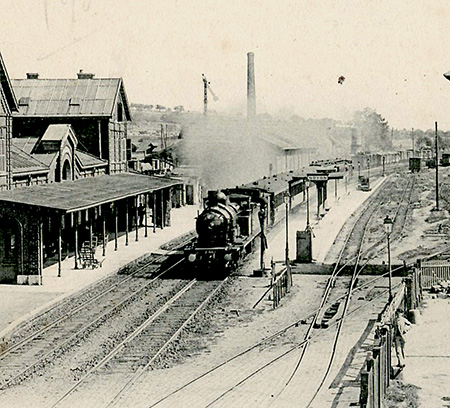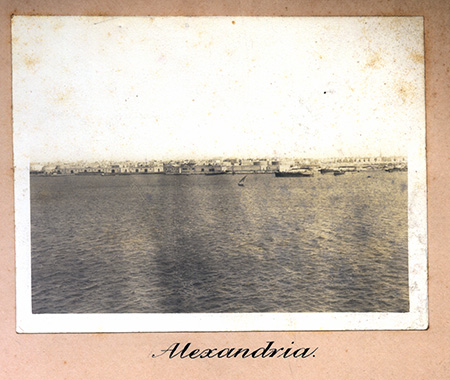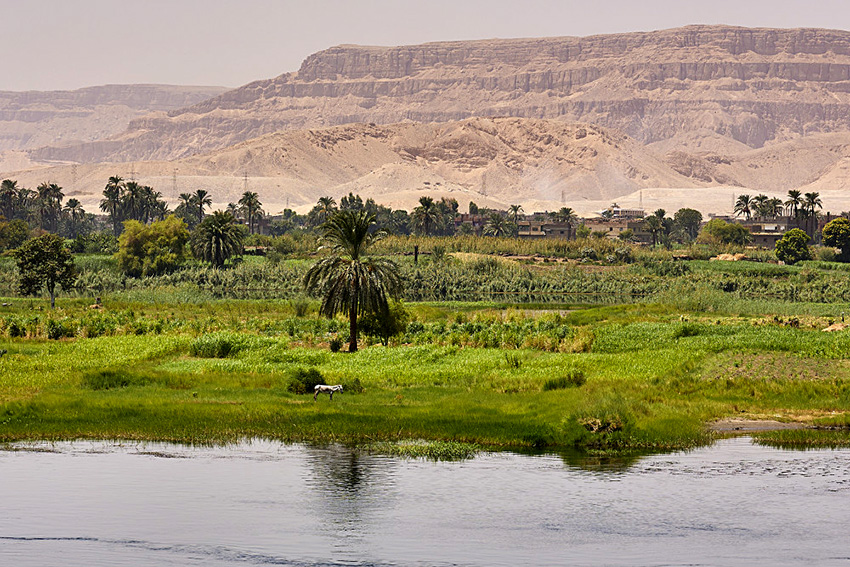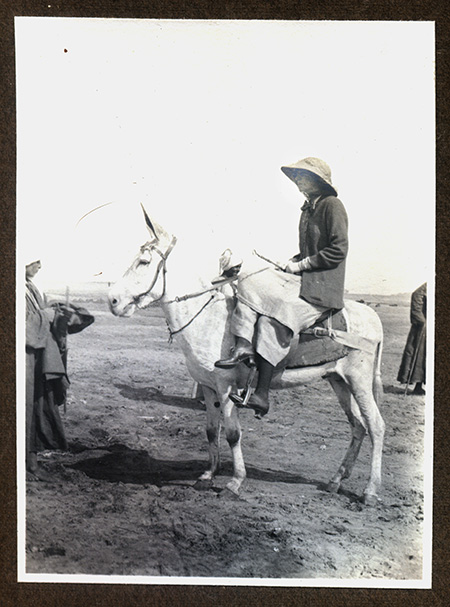
 Go down to the Egyptian exhibition here at Highclere and look across the first room showing the highlights of the story of the 5th Earl of Carnarvon. Look past the 3,000-year-old coffin of Irtyru and you will see a solid old grey door in the far corner.
Go down to the Egyptian exhibition here at Highclere and look across the first room showing the highlights of the story of the 5th Earl of Carnarvon. Look past the 3,000-year-old coffin of Irtyru and you will see a solid old grey door in the far corner.
If you pull it open and peek around the corner you will find some unexpected people: the space is decorated as a wallpapered cosy ante room containing the figures of Lord Carnarvon and Howard Carter around a desk. In reality, it is their replicas – modern well-dressed mummies – but nevertheless it does make quite a few people start, no doubt helped by the low-level lighting!
Recovering, you continue on and are met by a life size photograph of both men. I hope you almost feel as if you can shake hands with them. Walk on through into what was once a beer cellar and you can begin to explore some the 5th Earl’s life here at Highclere.
 One display cabinet focuses on travel and sets out how he made the journey to Egypt every year. It is some 3,500 miles from Highclere to Cairo and for centuries the major part of visiting another country was simply getting there, the journey itself far more of an adventure and more social than just navigating the passport queues and shops of an airport terminal.
One display cabinet focuses on travel and sets out how he made the journey to Egypt every year. It is some 3,500 miles from Highclere to Cairo and for centuries the major part of visiting another country was simply getting there, the journey itself far more of an adventure and more social than just navigating the passport queues and shops of an airport terminal.
Lord Carnarvon’s route usually took him first by car to Southampton, thence by boat to France and thence by train to Paris, a city he loved. Given he was more or less fluent in French, he enjoyed browsing the antique bookshops and visiting his friends there.  From there, it was a train down to Marseilles where he would board a ship which sailed around the Mediterranean, stopping at two or three Italian ports before setting a course towards the north coast of Egypt.
From there, it was a train down to Marseilles where he would board a ship which sailed around the Mediterranean, stopping at two or three Italian ports before setting a course towards the north coast of Egypt.
In early November 1922, Howard Carter had cabled Lord Carnarvon believing he might have found a entrance to a tomb so Lord Carnarvon had quickly booked himself and his daughter Evelyn passage to Egypt. His wife Almina was feeling entirely rotten with dreadful toothache so had decided she was quite unfit to travel.
 Lord Carnarvon always welcomed the warm dry weather of Egypt and enjoyed looking over the ship rails for the first glimpse of the white houses and mosques which marked the port of Alexandria.
Lord Carnarvon always welcomed the warm dry weather of Egypt and enjoyed looking over the ship rails for the first glimpse of the white houses and mosques which marked the port of Alexandria.
As the ship slowly docked, the medley of colour, noise, donkeys and shouting of local men and boys was wonderfully present once more. The huge ship creaked and clanged as it went through the. process of docking, loud rending sounds more appropriate to a huge beast slowly sighing before ropes safely halted the forward movement.
Disembarking into the colourful noise Alexandria, Lord Carnarvon and Evelyn caught the train south to Cairo where they spent a night at the Continental Hotel, which he preferred to Shepheard’s – he enjoyed the peace of the garden square.

Fernside, his valet, had then organised a railway carriage down to Luxor and only two weeks after departing Highclere, Lord Carnarvon was being greeted on the platform of Luxor railway station by his old friend the Chief of Police and Howard Carter whilst Evelyn was offered bouquets of flowers. Jumping into a taxi, a little horse drawn carriage, they repaired to the Winter Palace Hotel.
Sitting down with Howard Carter with his favourite Turkish cigarettes and thick dark local coffee, Lord Carnarvon listened intently and was up at first light the following morning to cross the Nile and meet his awaiting donkey to travel the final few miles to the Valley of the Kings.

The rest of that visit to Egypt became one of the great newspaper sensations of the modern world and a pivotal moment in Egyptian history, when an Earl found a Pharaoh.








 Instagram
Instagram
always interesting stories you have .
My goodness! Thank you Lady Carnarvon for taking us on a vivid journey with the 5th Earl. Truly refreshing.
I wonder if a new series isn’t in the offing, “The Earl and the Pharaoh”
I would love that!!!!
Good evening from Brazil,
The must better, new serie … “The Earl and The Pharaoh ” … So lovely…Yes,Yes …
Lovely week-end milady.
always interesting stories you tell .
Such interesting information. We loved the exhibit when we visited.
Thank you for sharing
It was an amazing story that still excites people today. How brave they were to travel so far on an adventure of their interests. It’s to bad the Earl didn’t live long enough to realize their findings.
Thank you for again sharing a wonderful story of the past which Highclere is a part of.
I have enjoyed my two visits to your beautiful Highclere, I recently saw a show with you & Mary Berry ( country secrets) & got to see your real kitchen.
Mary Berry is magic..
Lovely the pictures of Car ,Ship, Train Boat and Donkey did you have and lord Carnarvon and lovely to visit highcelere castle and l am fan of Downton Abbey thank you for the email
2 weeks to Egypt….Always fascinating. Cheers
I did enjoy the Egyptian exhibition at Highclere. The Earl had a fascinating life. I also found it interesting that the next Earl had no interest in anything to do with Egypt and Pharaohs and had “hidden” the artifacts. Every room I entered had a wonderful history. Highclere was the highlight of my last trip to Britain.
Hi Colleen
The 6th Earl thought that the 5th Earl had such bad luck so he didn’t want that bad luck to continue so he didn’t pursue further discoveries. My book explains this.
Impressive travel & daily details that were kept from way back then and you are able to put them all together! Thank you again Lady Carnarvon for another informative and entertaining Monday Blog. As I have been via his trails in Egypt and to your Egypt Exhibit there in Highclere you & Lord Carnarvon have honored and paid tribute to the 5th Earl and Howard Carter wonderfully and also with the Pharaoh Book you’ve written.
Thank you
Thank you for a lovely morning read. I’m pleasantly surprised when I open my email and find your faithful blog post. It’s there every Monday morning and I forget about it till I see it in front of my face. A small happy for the start of the week. Thank you.
Thank you Holly.
Good morning Lady Carnarvon: (8:37 am here in Canada)
I hope there is more to this story or possible an existing book I can source out to keep reading.
Regards, Corinne
Hello Corinne
You can find a lot more in my book The Earl and the Pharaoh.
Thanks for sharing this very interesting story. It’s amazing that even small details (like a toothache) were preserved in this story after all these years. Love hearing stories from the past!
Dear Lady Carnarvon,
I’m so grateful to hear this from your lips. The books written about the 5th Earls travels are simple not as clear. His daughter Evelyn was extremely lucky to join him. Can you please tell us more about her when your schedule allows.
Thank you very much,
Mary Kinne Descy
USA-descendant of Wm Brewster
Good Evening
There is quite a lot in the book I have written called “The earl and the pharaoh”
Thank you for sharing this historical travel event. My husband and I went to Luxor and marveled at the magnificent columns giving a glimpse of a life we can only imagine. One small snag: We got stuck in the elevator at our hotel and had to rely on our urgent screams in English to translate that we were trapped between floors. Their kindness transcended the language barrier and we were helped to crawl out landing only a small distance to the safety of a floor.
An adventure – if unexpected!
What a wonderful story. Thank you for sharing and describing a very different life from what we have today. My first visit to Egypt was 25 years ago and I completely fell in love.
Good Monday morning dear Lady,
As always, we look forward to opening our email to find such glorious descriptions of sites, sounds and adventures from your neck of the woods. I am a history buff and this post was especially fantastic! I should have been an archeologist who got to explore our hidden history! The 5th Earl was so fortunate be part of such a tremendous find for future generations to enjoy! Once again, thank you for sharing with us all.
Brenda Watson
Martinsville, Ohio
USA
Dear Lady Carnarvon,
What a lovely play by play, it seems as if you were there. Have a great rest of your day.
PS- next time we are at the Castle I am going to open the door.
I am so pleased to know this. It was a little bit skipped over in your book and I had worked out the route but was not aware how long it took or how far it was. We jump on and off planes now without a second thought about how this was achieved back in the day. Travel meant exactly that and must have contributed to a sense of a different place on arrival, moving through the different countries en route and experiencing the vagaries of weather and schedules that were not kept no doubt.
When writing you always have to cut!
My dear lady Fionna,
Good morning from Brazil.
Rio Claro 40° celcius. warm, warm day. 11h:40m.
Ten one day, years ago, i found out that the 5th Earl of Carnarvon, was in the City of Rio de Janeiro ,Brazil, with his sailboot and that he also arrived with him as far as Buenos Aires. Incredible man!!!!! How much he traveled the world.
Lovely week for you milady,your new book is absoluting stunning.
Thank you very much.
My dear lady Fionna,
Good morning from Brazil.
Rio Claro 40° celcius. warm, warm day. 11h:40m.
Then one day, years ago, i found out that the 5th Earl of Carnarvon, was in the City of Rio de Janeiro ,Brazil, with his sailboot and that he also arrived with him as far as Buenos Aires. Incredible man!!!!! How much he traveled the world.
Lovely week for you milady,your new book is absoluting stunning.
Thank you so much!
So good to see your blog this lovely sunny Monday and read the human story behind the great discovery of Tut’s tomb. Imagine the Earl’s heightened level of anticipation as he traveled for two weeks to arrive in Egypt: would it be another wild-goose-chase, or had Carter really found something worth excavating? I just had to open up your book The Earl and the Pharaoh and page through its fascinating story once again. Thank you for all the tales you tell and incite us to delve deeper into the Earl’s life and the life at Highclere.
Thank you Catherine, I’m so pleased you’ve enjoyed the book.
Wonderfully written! Felt like I was actually on the journey.
Good afternoon, dear Lady Carnarvon. Once again I thank you for your fun blog! I really enjoy reading these on Monday mornings. I really am going to read your book, The Earl and the Pharaoh. I’ve also just recently discovered your podcast, and am following those. I listened last week to the one with author Victoria Hislop. Her book, The Island, sounds intriguing; I am going to suggest it to my book club as a book for us to read next. I love the photos in this Monday blog. Evelyn must have been an intrepid young woman — and she, of course, had to ride side saddle on the donkeys! Have a wonderful and productive Monday, Lady Carnarvon, and tell us more about what book you plan to write next (or are currently writing now.
Warm regards,
Suzanne in Georgia (U.S.)
Thank and please se propose my book too to your book club!!
Lady Carnarvon,
After reading your story, I went back to your book, The Earl and the Pharoah, to re-read portions about the ‘after’ of getting to Egypt and exploring the tomb. It reminded me again of the awesome exhibit we saw in 2013 at Highclere.
It’s interesting how we think travel was so arduous in the Earl’s lifetime, when actually he must have been quite pleased that it was so easy!
Thank you for another inner glimpse of your family’s amazing history!
Martha G.
Thank you, Happy Holidays and Long Life beyond 2024 for many, many years to follow! -Josie
Such interesting information . Thank you . I enjoyed reading this.
Lady Carnarvon,
My husband and I have just returned from a wonderful 3 weeks in England!! While in Stratford upon Avon we went out in the country to visit Charlecote Park and the 800+ year old Lucy family house which is still has a relative living in one wing. One of the volunteer docents shared a story of a Lucy family connection to Highclere Castle and the Carnarvon family. But sadly we cannot recall the details. Might you know of this connection between the 2 family estates?
The Lucy family were briefly involved at Highclere between the Bishops 800 year old ownership and the Carnarvon family
Dear Lady Carnarvon,
I listened to your book The Earl and The Pharoah in audiobooks and thoroughly enjoyed it. This amazing story will live on in people’s imaginations forever I believe. What an amazing achievement by the 5th Earl and Howard Carter. It’s sad to think the 5th Earl passed away so soon afterwards.
Your blog and the wonderful photos are really interesting – a glimpse into history. Thank you.
Thank you – I enjoyed recording it
Dear Lady Carnarvon,
As always your writings on Lord Carnarvon and Egypt bring me to a place I would loved to have been part of. The photos are excellent. I do like the one with you next to the Lord and Carter. Maybe one day I will see the Egyptian treasures at Highclere. One can always dream. Take care.
Susan
What an evocative posting. It reminded me of one of my favorite passages about travel in that era (the narrator is an upper-class Englishwoman, ensconced on the upper deck of the ship while it docks in Turkey): “The boats were filled mostly with steerage passengers who lived in Trebizond or were visiting relations there, and the women carried great bundles and sacks full of things, but the men carried suit-cases with sharp, square corners, which helped them very much in the struggle to get on and stay on the boats, for this was very violent and intense. More than one woman got shoved overboard into the sea during the struggle, and had to be dragged out by husbands and acquaintances, but one sank too deep and had to be left, for the boat-hooks could not reach her; all we saw were the apples out of her basket bobbing on the waves. I thought that women would not stand much chance in a shipwreck, and in the struggle for the boats many might fall in the sea and be forgotten, but the children would be saved all right, for Turks love their children, even the girls.”
― Rose Macaulay, The Towers of Trebizond
I have to say that the scene doesn’t sound much different from the Atlanta airport today…..100 years later.
Sincerely, David Terry
Golly well I guess people do not change! I hope not everyone is that desperate today..
I love the line, “…and only two weeks after departing Highclere, Lord Carnarvon was being greeted on the platform of Luxor railway station…” You really wanted to travel somewhere to go through all of that to get there! What an adventure for his daughter! Thank you for the glimpse of the journey to Egypt.
I so enjoy reading your wonderful blogs. Egypt is a fascinating land with so much yet to be discovered. I try to watch all of the documentaries available on Egypt and any new discoveries. Thank you for sharing and enabling us to feel part of the story.
More news from far away and long ago and such an easy read. It would be wonderful to learn via your blog how Highclere prepares for winter: what do the gardeners do at the greenhouse, how is the barn coming along, how are the animals housed when it’s truly, truly cold. Thanks for considering.
The Barn is progressing – thank you and Hampshire Oak have made me some new benches and repaired the old for around the cedar airmen…small steps too!
Dear Lady Carnarvon,
I love visualizing your words and re-living the experience. It helps to have toured the Egyptian Exhibit, which was absolutely AMAZING. It truly brings the experience to life especially after reading the book, which has become one of my favorites! It is so well written.
I hope to visit Egypt and the pyramids one day. It is on my bucket list! Thank you for all the great history lessons you provide weekly!
All the best,
Patsy A.
Thank you Patsy, I hope you are are well.
Sending our love.
Dear Lady Carnarvon,
I always look forward to your weekly blogs and reading today’s reminded me to thank you for the two books you have beautifully written Lady Almina and the Real Downton Abbey. Plus the sequel Lady Catherine and the Real Downton Abbey. Highly recommend them to your followers of FeedBlitz. It was fun to try to match the real life people with the characters in Downton Abbey. Some are fairly obvious and suppose there was some creative license given Julian Fellowes as he masterfully introduced the world to a time gone by and Highclere Castle.
Thank you and I hope you have enjoyed the Earl and the Pharaoh?
Love the history and you story,as always, very enjoyable to read!
All the best!
Lady Carnarvon…………I so love reading you tales of the 5th Earl. I recently bought your books of Lady Almina and Lady Catherine.
I’ve been busy with guests this week. So I am anxious to start reading them when they leave. I think the current Earl was very fortunate to have found you.
I enjoy writing – I hope you will turn to the Earl and the Pharaoh after those!!! I hope you cannot put them down
I cannot thank you enough for writing this blog. It has brought me so much pleasure. I will never be able to explain why or how. Suffice to say that my first memory of ever wanting to be something when I grew up was an archeologist or Egyptologist, thanks to the discovery of King Tutankhamun’s tomb. It was some time before I realized, as an adult, that both those pursuits involved an awful lot of time spent in the heat of Egypt and in the dirt of excavations there. Little did I realize after falling in love with Downton Abbey, that so many of my interests would come together and reading your blog today touched on each.
I so hope to one day travel to Highclere, but as someone suffering from metastatic breast cancer, such a trip may not be in my future. It is, however, much more likely than a trip to Egypt, so I will continue to hope. I will also continue to enjoy your blog. Please know it is very important to many people who may never write!
Thank you and I hope you will read the Earl and the Pharaoh and not be able to put it down – he inspired many people
“Can you see anything?”
“Yes, wonderful things!”
Mmph. Still gives me the chills.
Dear Lady Carnarvon,
The Earl and the Pharaoh is a adventure I would have liked to take.
Hello from St Augustine Fl. Just got to your great e-mail. Thank for making my day.
fondly Jenny
Put things in perspective when today no part of the world is more than a day’s flight away – apart from the polar regions. We have however after reading your post lost a lot of the romance of travel and the anticipation of arrival these days
Hi Lady Carnarvon
You really have managed to capture the romance and excitement of travel in the 1920’s and thirties.
I have travelled as far as Marseilles by train. it really is so much better than flying and better for the environment. I did travel on to Cairo too but by ‘plane. Work insisted. I however, would have happily sailed to Cairo. Thankyou for putting into words a sense of that era. I know the story of the discovery of Tutankhamun’s tomb very well. It’s always wonderful to get a personal view though.
Lady Carnarvon,
What a fascinating blog! I will be looking for your The Earl and the Pharaoh book.
Dear Lady Carnarvon:
Thank you for this Monday’s blog and for taking us on this adventure. As with your book, The Earl and the Pharoah, you draw the reader into the story.
As a side note, and when convenient, please read the November 3, 2022, story https://www.smithsonianmag.com/history: How Howard Carter Discovered King Tut’s Tomb.
Until next time, may you continue to have exciting travels.
Perpetua Crawford
I was gifted your book, The Earl and the Pharaoh and to be honest, doubted I would ever read it.
Well, I am pleased to say that I have just finished it! I found it hard to put down as it is so very well written and enjoyable.
Thank you Lady Canarvon
Thank you Denise.